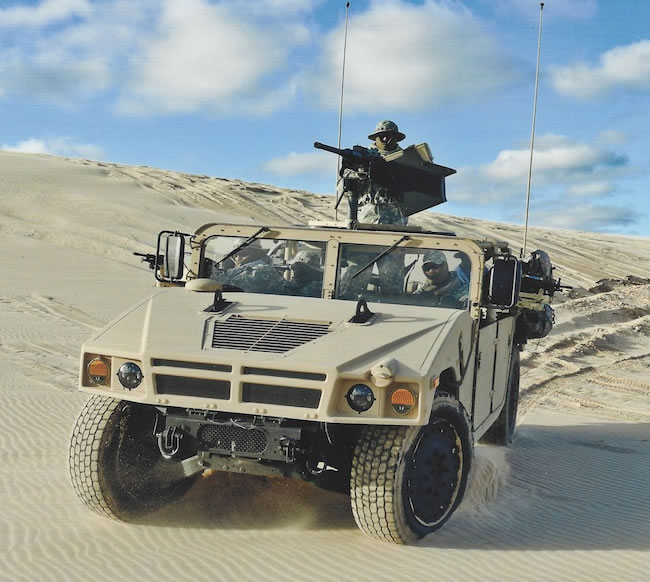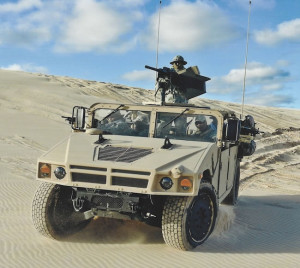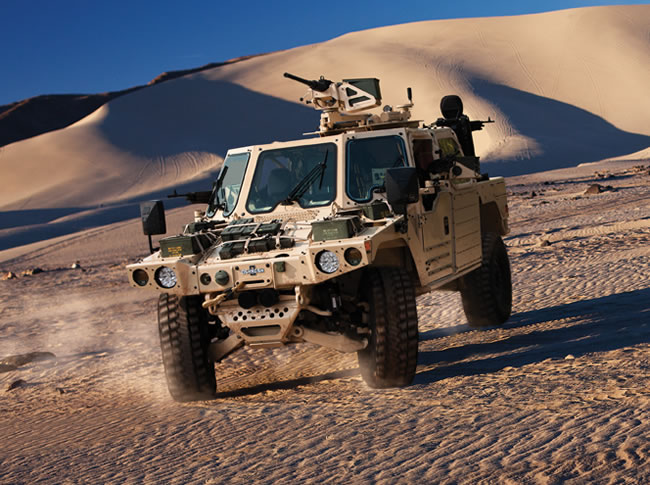

As heavy combat vehicle programs are idling, modernization of the tactical vehicles is in progress, as the Army, Marine Corps and Special Operations Command plan to replace and reset their fleet of High Mobility Multipurpose Wheeled Vehicles (HMMWV). Two vehicles classes are currently underway – the Joint Light Tactical Vehicle (JLTV), equipping the Army and US Marine Corps, and the Ground Mobility Vehicle (GMV) 1.1 – replacing the HMMWVs operated by the Special Operations Command.
JLTV is currently underway, as the services await the delivery of 22 vehicles from three competitors. Following the scheduled testing the Army will select a single vendor to produce 55,000 vehicles or more, replacing HMMWVs currently in service. Since the Army has stressed cost limitations as its highest consideration, all three competitors are offering conventional, diesel powered vehicles, leaving more exotic hybrid electric drives for future upgrades. To reduce cost while meeting weight and size restrictions, manufacturers are employing advanced engineering and manufacturing techniques to minimize weight, while adhering to conventional materials over advanced, high performance composites (reducing material and production costs). For example, in the prototypes Lockheed Martin plans to deliver in about 10 months, the company is using thinner but stronger steel, rather than the lighter but expensive and hard to process aluminum alloys previously used, saving cost and also enabling easier repair in the field. The weight gain resulting from the use of heavier materials was balanced by optimizing design, engineering and manufacturing, therefore limiting the weight increase. The JLTV has already demonstrated helicopter sling-load carriage.

Even when the JLTV is fielded, HMMWVs will still be around, and require ongoing sustainment and support. AM General, the vehicle manufacturer and one of the three finalists for JLTV is also offering a new version of the HMMWV designed for special operations. The HMMWV based GMV, positioned by the company as the ‘next generation vehicle’, which takes the original GMV 1.0 (SOCOM HMMWV) to the next level of performance, mobility and transportability (it is designed for internal transportation in the CH/MH-47 Chinook). This HMMWV is powered by a GEP Optimizer 3200 diesel supporting 300 miles operating range. This version has a lower curb weight and higher gross vehicle weight (GVW), compared to the GMV 1.0. It has full independent suspension for all-terrain mobility, off-road and on road. The vehicle has six articulated weapon mounts and greater stowage capacity, and, along with sustainable highway speed of 80 mph and high dash speed, is well positioned to answer special ops requirements.
AM General is not the only company showing vehicles for the GMV 1.1 selection. In fact, all the competitors that are still among the qualified finalists for the programs were there – GDLS, with the Specter, Oshkosh defense unveiled the S-ATV at the Modern Day Marine event, Navistar Defense displayed their pick-up sized ‘Special Operations Tactical Vehicle (SOTV) at AUSA and the BAE-Northrop Grumman team that launched the new MAV-L, ccustom built prototype developed specifically for the GMV 1.1 program by racing specialist Pratt Miller.
Absent of other new starts in the Army tactical vehicle arena, SOCOM is attracting much interest among tactical vehicle manufacturers. Apart from the GMV 1.1 program that sees the acquisition of at least 1,300 vehicles over the next seven years, SOCOM also plans to buy hundreds of additional special purpose off-road vehicles for long range recon missions, personnel extraction and other special missions. Required to be even more maneuverable and agile than the GMV, these vehicles are attracting specialty vehicle providers such as HDT, Flyer defense (teamed with General Dynamics) and Polaris Defense – all were present at this year’s AUSA and MDM. Designed as a ‘low profile’ vehicle, Navistar’s SOTV could be applied for several SOCOM programs – including GMV 1.1.




















